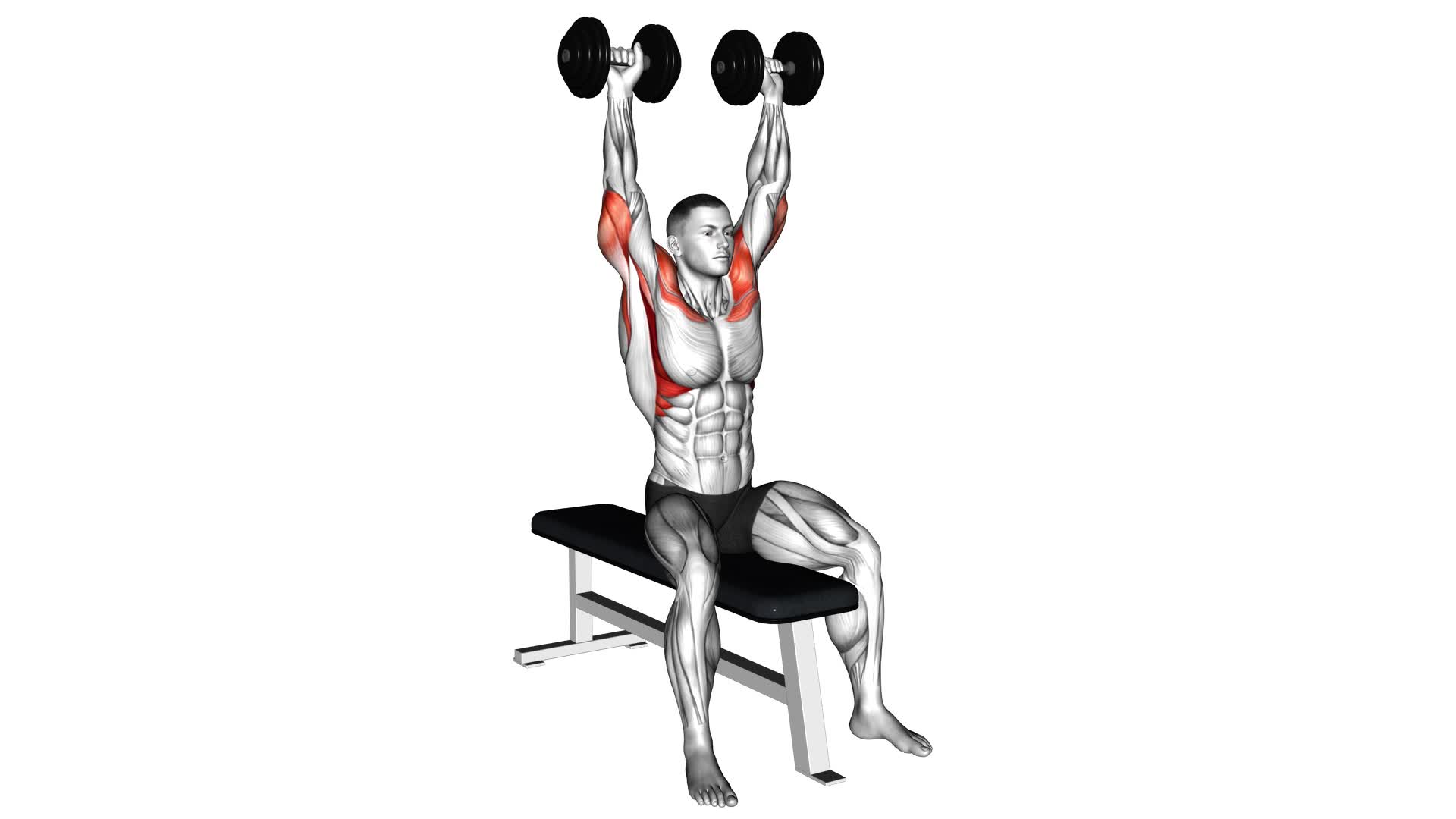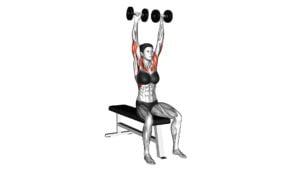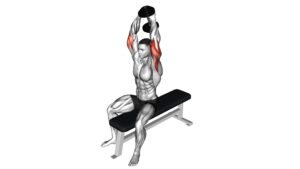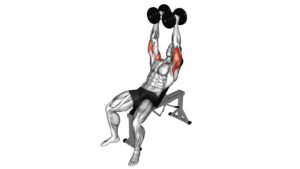Dumbbell Bench Seated Press – Video Exercise Guide & Tips

Are you looking to amp up your upper body strength? The Dumbbell Bench Seated Press is the perfect exercise for you!
Watch This Exercise Video
In this video exercise guide, you'll learn the proper form and technique to maximize your results. From variations and progressions to common mistakes to avoid, we've got you covered.
So grab your dumbbells and get ready to feel the burn with this effective workout.
Let's dive in!
Key Takeaways
- Increased muscle activation in shoulders, chest, and triceps
- Improved shoulder stability
- Builds strength and definition in targeted areas
- Activates triceps for arm extension
Benefits of the Dumbbell Bench Seated Press
You will experience several benefits from incorporating the dumbbell bench seated press into your workout routine. One of the main advantages is increased muscle activation. This exercise targets the muscles in your shoulders, chest, and triceps. As you press the dumbbells upwards, your deltoids and pectoral muscles are engaged, helping to build strength and definition in these areas. Additionally, the triceps are activated as they assist in extending your arms.
Another benefit of the dumbbell bench seated press is improved shoulder stability. During this exercise, you're seated on a bench with your back supported, which allows you to focus on stabilizing your shoulder joints. This can help to reduce the risk of injury and improve overall shoulder function. By strengthening the muscles surrounding the shoulder joint, such as the rotator cuff muscles, you can enhance stability and prevent imbalances.
Incorporating the dumbbell bench seated press into your routine can provide you with significant benefits, including increased muscle activation in the shoulders, chest, and triceps, as well as improved shoulder stability. By including this exercise in your workout, you can target specific muscle groups and enhance your overall upper body strength and stability.
Proper Form and Technique
To perform the dumbbell bench seated press with proper form and technique, focus on maintaining a stable and controlled movement throughout the exercise. Here are some key points to keep in mind:
- Keep your back flat against the bench and your feet planted firmly on the ground to ensure stability.
- Hold the dumbbells with an overhand grip, palms facing forward, and position them just outside your shoulders.
As you press the dumbbells upward, make sure to:
- Keep your elbows slightly bent to avoid locking them out at the top of the movement.
- Lower the dumbbells slowly and under control, keeping them in line with your chest and not allowing them to drop too far down.
- Avoid arching your back or using momentum to lift the weights. This can lead to improper form and potential injury.
Common mistakes to avoid include:
- Flaring your elbows out to the sides, which puts unnecessary strain on the shoulder joints.
- Not fully extending your arms at the top of the movement.
As for training frequency, it's recommended to:
- Incorporate the dumbbell bench seated press into your upper body workout routine 1-2 times per week.
- Allow for proper rest and recovery between sessions.
Variations and Progressions
Now let's talk about how you can progress and modify the dumbbell bench seated press to challenge yourself and continue seeing results.
One way to progress is by increasing the weight you use for the exercise. By gradually adding more weight over time, you can continuously challenge your muscles and promote strength gains.
Additionally, there are modifications available for different fitness levels, such as using resistance bands or adjusting the bench angle. These variations can help target different muscles and add diversity to your workout routine.
Exploring these options can offer a range of benefits, including improved muscle strength, stability, and overall fitness.
Increasing Weight for Progress
To progress in increasing weight for the dumbbell bench seated press, focus on incorporating variations and progressions into your routine. This will help you gradually increase the intensity of your workouts and track your progress more effectively.
Here are three ways to do it:
- Increase Reps or Sets: Start by adding an extra set or a few more reps to your current weight. This will challenge your muscles and gradually increase the workload.
- Decrease Rest Time: As you get stronger, try reducing the rest time between sets. This will increase the intensity of your workouts and help you build endurance.
- Use Heavier Weights: Gradually increase the weight of the dumbbells you use for the bench seated press. Start with a weight that challenges you, but allows you to maintain proper form, and gradually work your way up.
Modifications for Different Levels
Incorporating variations and progressions into your routine allows you to modify the dumbbell bench seated press for different levels of fitness. To make the exercise more challenging, you can increase the weight of the dumbbells or use different equipment such as resistance bands or kettlebells. However, it's important to prioritize safety precautions when making these modifications.
Always choose a weight or resistance level that allows you to maintain proper form and control throughout the exercise. Start with lighter weights and gradually increase the load as your strength and technique improve. Additionally, consider working with a fitness professional to ensure proper technique and to prevent any potential injuries.
Benefits of Variations
As you explore variations and progressions of the dumbbell bench seated press, you can experience a range of benefits that enhance your strength and fitness levels.
Here are some key benefits to consider:
- Different grip options: By changing your grip on the dumbbells during the bench seated press, you can target different muscles and improve overall upper body strength. For example, using a neutral grip (palms facing each other) can engage the shoulder and triceps muscles more, while a pronated grip (palms facing away from you) can activate the chest muscles.
- Incorporating stability ball: Performing the dumbbell bench seated press on a stability ball adds an extra element of instability, challenging your core muscles to work harder to maintain balance. This can help improve your overall stability and coordination.
- Increased muscle activation: Variations of the dumbbell bench seated press, such as incline or decline presses, can target specific muscle groups more effectively. Incline presses focus on the upper chest, shoulders, and triceps, while decline presses engage the lower chest and triceps.
Common Mistakes to Avoid
Avoidance of these common mistakes will enhance the effectiveness of your dumbbell bench seated press. Proper execution of this exercise is crucial to maximize its benefits and prevent injuries.
One common mistake is using too much weight. It's important to start with a manageable weight and gradually increase it as your strength improves. Using excessive weight can compromise your form and put unnecessary strain on your muscles and joints.
Another mistake to avoid is arching your back. Maintaining a neutral spine throughout the exercise is essential for targeting the intended muscles and preventing lower back pain. Engage your core and keep your back flat against the bench.
Improper grip is also a common mistake. Make sure to hold the dumbbells firmly, with your palms facing forward and your wrists aligned with your forearms. This grip will help stabilize the weights and promote proper alignment of your shoulders and elbows.
Lastly, rushing through the exercise is a mistake that many people make. Take your time and focus on the movement. Lower the dumbbells slowly and with control, and then press them back up explosively. This slow and controlled tempo allows for better muscle activation and prevents jerky movements that can lead to injuries.
Tips for Maximizing Results
To maximize your results with the dumbbell bench seated press, it's important to focus on proper form techniques. This means maintaining a stable and controlled movement throughout the exercise, avoiding any jerky or swinging motions.
Additionally, incorporating the exercise into your training routine with the recommended frequency will help you see improvements in strength and muscle growth.
Proper Form Techniques
To maximize your results, focus on maintaining proper form while performing the dumbbell bench seated press. Here are some tips to help you get the most out of this exercise:
- Common Mistakes:
- Arching your back: Keep your back flat against the bench to engage your core and prevent strain on your lower back.
- Using too much weight: Start with a weight that allows you to maintain proper form throughout the entire movement.
- Flaring your elbows: Keep your elbows tucked close to your body to target your chest muscles effectively.
- Training Frequency:
- Aim to perform the dumbbell bench seated press 2-3 times per week, allowing at least one day of rest between sessions.
- Start with a weight that challenges you but still allows you to complete 8-12 repetitions with proper form.
- Gradually increase the weight as you get stronger, but always prioritize maintaining proper form over lifting heavier weights.
Training Frequency Recommendations
How often should you perform the dumbbell bench seated press to maximize your results and achieve your goals?
The training frequency for the dumbbell bench seated press will depend on your individual fitness level and goals. For beginners, it's recommended to start with 2-3 sessions per week. As you progress and become more experienced, you can increase the frequency to 3-4 sessions per week.
It's important to balance training intensity with adequate rest periods to allow for proper muscle recovery and growth. Aim to have at least one day of rest between each session to prevent overtraining and reduce the risk of injury.
Now that you know the recommended training frequency, let's move on to the next section to learn about a sample dumbbell bench seated press workout routine.
Sample Dumbbell Bench Seated Press Workout Routine
Looking to maximize your strength gains with the dumbbell bench seated press? Follow this sample workout routine to achieve optimal results:
- Start with a warm-up set using light weights to prepare your muscles for the upcoming workout.
- Perform 3 sets of 8-10 reps of the traditional dumbbell bench press. This exercise targets the chest, shoulders, and triceps.
Incorporate dumbbell bench press variations such as the incline press and decline press to target different areas of the chest.
Increase the weight gradually as you progress to challenge your muscles and stimulate growth. Aim to add 5-10 pounds to each dumbbell every week or two.
Take adequate rest between sets to allow for muscle recovery and prevent fatigue.
Include other upper body exercises such as shoulder presses, tricep dips, and chest flyes to add variety and work different muscle groups.
Aim to perform the dumbbell bench seated press workout routine 2-3 times a week, allowing for at least one day of rest between sessions.
Remember to maintain proper form throughout the exercises, focusing on controlled movements and engaging the target muscles.
Lastly, listen to your body and adjust the weights and repetitions as needed to ensure a challenging yet safe workout.
Frequently Asked Questions
How Much Weight Should I Start With for the Dumbbell Bench Seated Press?
When starting the dumbbell bench seated press, it's important to choose a weight that challenges you but allows for proper form. Start with a weight that you can comfortably lift for 8-12 reps with good technique. This will vary depending on your strength level.
Remember to maintain a stable position on the bench, engage your core, and keep your shoulders down and back throughout the exercise.
Gradually increase the weight as you get stronger and more comfortable with the movement.
Can the Dumbbell Bench Seated Press Help With Building Chest Muscles?
The dumbbell bench seated press is a great exercise for building chest muscles. It targets the pectoral muscles and helps increase their size and strength.
To get the most out of this exercise, it's important to use proper form. Start with a weight that challenges you but allows you to maintain good technique. Keep your back flat against the bench, lower the dumbbells to your chest, and press them back up, focusing on contracting your chest muscles.
Is It Necessary to Have a Spotter While Performing the Dumbbell Bench Seated Press?
When performing the dumbbell bench seated press, you might be wondering if you need a spotter. Well, the answer is, it depends.
Having a spotter can be beneficial because they can help you lift heavier weights and provide safety in case you struggle.
However, if you're confident in your abilities and using lighter weights, you can do this exercise solo.
Can the Dumbbell Bench Seated Press Help With Improving Shoulder Stability?
The dumbbell bench seated press is a great exercise for improving shoulder stability. By doing this exercise, you can strengthen the muscles around your shoulders, which helps to stabilize them during other movements.
The technique for this exercise is important to ensure proper form and maximize the benefits. Make sure to maintain a neutral spine, engage your core, and press the dumbbells directly overhead.
This exercise can be done without a spotter, but it's always a good idea to have one for safety.
Are There Any Modifications or Alternatives for Individuals With Shoulder Injuries or Limitations?
If you have shoulder injuries or limitations, there are alternative exercises and shoulder-friendly modifications that you can consider. These modifications can help you work out without aggravating your shoulder.
Additionally, there are alternative exercises that target the same muscle groups as the dumbbell bench seated press, but with less strain on your shoulders. These alternatives can be just as effective in helping you improve your upper body strength and stability.
Conclusion
In conclusion, the dumbbell bench seated press is a highly effective exercise that targets the shoulders, triceps, and chest muscles.
By maintaining proper form and technique, you can maximize the benefits of this exercise and avoid common mistakes.
Adding variations and progressions to your routine can help you continually challenge your muscles and promote growth.
Remember to prioritize safety and start with lighter weights before progressing to heavier ones.
Incorporate the dumbbell bench seated press into your workout routine for improved upper body strength and muscle development.

Author
Years ago, the spark of my life’s passion ignited in my mind the moment I stepped into the local gym for the first time. The inaugural bead of perspiration, the initial endeavor, the very first surge of endorphins, and a sense of pride that washed over me post-workout marked the beginning of my deep-seated interest in strength sports, fitness, and sports nutrition. This very curiosity blossomed rapidly into a profound fascination, propelling me to earn a Master’s degree in Physical Education from the Academy of Physical Education in Krakow, followed by a Sports Manager diploma from the Jagiellonian University. My journey of growth led me to gain more specialized qualifications, such as being a certified personal trainer with a focus on sports dietetics, a lifeguard, and an instructor for wellness and corrective gymnastics. Theoretical knowledge paired seamlessly with practical experience, reinforcing my belief that the transformation of individuals under my guidance was also a reflection of my personal growth. This belief holds true even today. Each day, I strive to push the boundaries and explore new realms. These realms gently elevate me to greater heights. The unique combination of passion for my field and the continuous quest for growth fuels my drive to break new ground.







